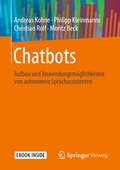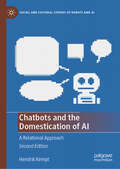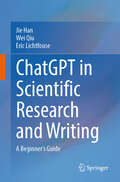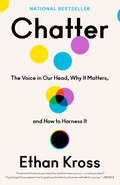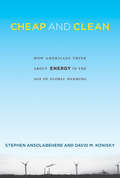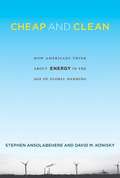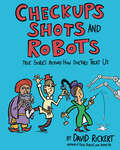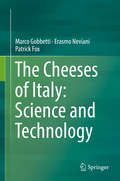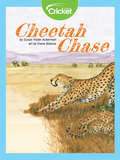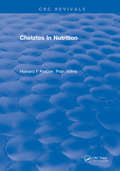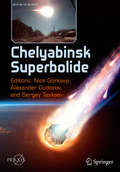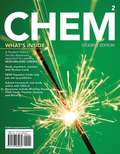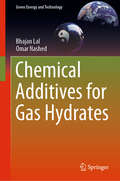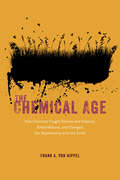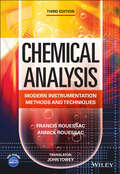- Table View
- List View
Chasing Venus: The Race to Measure the Heavens
by Andrea WulfThe author of the highly acclaimed Founding Gardeners now gives us an enlightening chronicle of the first truly international scientific endeavor--the eighteenth-century quest to observe the transit of Venus and measure the solar system. On June 6, 1761, the world paused to observe a momentous occasion: the first transit of Venus between the earth and the sun in more than a century. Through that observation, astronomers could calculate the size of the solar system--but only if they could compile data from many different points of the globe, all recorded during the short period of the transit. Overcoming incredible odds and political strife, astronomers from Britain, France, Russia, Germany, Sweden, and the American colonies set up observatories in remote corners of the world, only to have their efforts thwarted by unpredictable weather and warring armies. Fortunately, transits of Venus occur in pairs: eight years later, the scientists would have another opportunity to succeed. Chasing Venus brings to life the personalities of the eighteenth-century astronomers who embarked upon this complex and essential scientific venture, painting a vivid portrait of the collaborations, the rivalries, and the volatile international politics that hindered them at every turn. In the end, what they accomplished would change our conception of the universe and would forever alter the nature of scientific research.
Chatbots: Aufbau und Anwendungsmöglichkeiten von autonomen Sprachassistenten
by Andreas Kohne Philipp Kleinmanns Christian Rolf Moritz BeckChatbots setzen sich in vielen Bereichen für die Kommunikation mit Kunden, Mitarbeitern und Bürgern durch. Sie beantworten automatisch Anfragen, entlasten Hotlines oder beraten Kunden. In diesem Buch werden die technischen wie auch die sprachlichen Grundlagen von Chatbots ausführlich vorgestellt und anhand von praxisnahen Beispielen erläutert. Weiterhin werden wichtige Aspekte wie Kosten, Akzeptanz und rechtliche Grundlagen beleuchtet. Abschließend wird anhand eines konkreten Beispiels ein Chatbot-Projekt exemplarisch beschrieben.
Chatbots and the Domestication of AI: A Relational Approach (Social and Cultural Studies of Robots and AI)
by Hendrik KemptWith the publication of chatGPT in December 2022, a new era of artificial dialogue systems and chatbots has emerged. Many established thinkers and figures have published their stance on the development of this technology, not rarely combined with stark language about its transformative potential and potential risks. New terminologies have found entrance to public and philosophical discourse, new regulatory frameworks have been introduced, from small to large scale, and an entire economy has shifted: many apps have sprung into existence using chatGPT and other LLMs as a basis for their services, large corporations take the risks of releasing unfinished language models to undercut the competition. In the meantime, many more stakeholders have entered the economic, regulatory, and social discourses on how to deal with this emerging technology. Taking the latest developments in the field into consideration this completely revised and updated second edition now includes new chapters on the tech-ethics of Large Language Models and LLMs as relational technology. The author considers the consequences of chatbots on human-human relationships, providing analysis on robot rights, human-centered design, and the social tension between robophobes and robophiles.
ChatGPT in Scientific Research and Writing: A Beginner’s Guide
by Jie Han Wei Qiu Eric LichtfouseMost scientists are constantly under pressure for reading essential literature, designing new experiments, writing successful proposals and papers, and meeting deadlines. However, imagine that your brain is connected to the entire human knowledge and can extract instantly essential information for discovery. Imagine that research tasks that took days to months can now be done within few seconds. This is not science fiction anymore since the onset of generative artificial intelligence tools such as ChatGPT. This book explains concisely and simply how to use ChatGPT for identifying new results, crafting titles, editing language, interpreting figures, creating visuals, and refining methods. ChatGPT even allows for brainstorming, designing experiments, writing proposals, responding to reviewers, and evaluating research papers. Written for researchers with no background in coding or prompt engineering, this book provides the skills necessary to navigate the changing landscape of scientific research. In particular, you will learn how to leverage ChatGPT’s unique capabilities to generate ideas, streamline literature reviews, and craft compelling narratives. In short, this book empowers you to unlock the potential of ChatGPT, boosting productivity, and take your scientific research and writing to new heights.
Chatter: The Voice in Our Head, Why It Matters, and How to Harness It
by Ethan KrossNATIONAL BESTSELLER • An award-winning psychologist reveals the hidden power of our inner voice and shows how to harness it to combat anxiety, improve physical and mental health, and deepen our relationships with others.LONGLISTED FOR THE PORCHLIGHT BUSINESS BOOK AWARD • &“A masterpiece.&”—Angela Duckworth, bestselling author of Grit • Malcolm Gladwell, Susan Cain, Adam Grant, and Daniel H. Pink&’s Next Big Idea Club Winter 2021 Winning SelectionOne of the best new books of the year—The Washington Post, BBC, USA Today, CNN Underscored, Shape, Behavioral Scientist, PopSugar • Kirkus Reviews, Publishers Weekly, and Shelf Awareness starred reviewsIs talking to yourself normal? The truth is that we all have a voice in our head. When we talk to ourselves, we often hope to tap into our inner coach but find our inner critic instead. When we&’re facing a tough task, our inner coach can buoy us up: Focus—you can do this. But, just as often, our inner critic sinks us entirely: I&’m going to fail. They&’ll all laugh at me. What&’s the use? In Chatter, acclaimed psychologist Ethan Kross explores the silent conversations we have with ourselves. Interweaving groundbreaking behavioral and brain research from his own lab with real-world case studies—from a pitcher who forgets how to pitch, to a Harvard undergrad negotiating her double life as a spy—Kross explains how these conversations shape our lives, work, and relationships. He warns that giving in to negative and disorienting self-talk—what he calls &“chatter&”—can tank our health, sink our moods, strain our social connections, and cause us to fold under pressure. But the good news is that we&’re already equipped with the tools we need to make our inner voice work in our favor. These tools are often hidden in plain sight—in the words we use to think about ourselves, the technologies we embrace, the diaries we keep in our drawers, the conversations we have with our loved ones, and the cultures we create in our schools and workplaces. Brilliantly argued, expertly researched, and filled with compelling stories, Chatter gives us the power to change the most important conversation we have each day: the one we have with ourselves.
Chatter and Machine Tools
by Brian StoneFocussing on occurrences of unstable vibrations, or Chatter, in machine tools, this book gives important insights into how to eliminate chatter with associated improvements in product quality, surface finish and tool wear. Covering a wide range of machining processes, including turning, drilling, milling and grinding, the author uses his research expertise and practical knowledge of vibration problems to provide solutions supported by experimental evidence of their effectiveness. In addition, this book contains links to supplementary animation programs that help readers to visualise the ideas detailed in the text. Advancing knowledge in chatter avoidance and suggesting areas for new innovations, Chatter and Machine Tools serves as a handbook for those desiring to achieve significant reductions in noise, longer tool and grinding wheel life and improved product finish.
The Chatterbugs Manual: A 12-Week Speech, Language and Communication Programme for Early Years
by Andrea RichardsThe Chatterbugs Manual is a practical resource for all those supporting the development of the foundation communication skills of attention and listening, turn-taking and early vocabulary in children. The Chatterbugs programme has been designed to bridge the gap between education and specialist speech, language and communication provision, specifically with Early Years mainstream settings in mind. It enables school staff to prepare children—including those with delayed communication skills, EAL learners, or children with suspected special education needs—for learning in school by developing their communication skills through the use of robust communication strategies. The Chatterbugs Manual contains: An overview of the programme, including step-by-step instructions on how to plan and deliver a Chatterbugs session Guidance on identifying children likely to benefit from the programme Progress Tracking documents, along with information on measuring outcomes Child-friendly, illustrated session resources Frequently Asked Questions A parent-friendly information leaflet Information on models of implementation Information on accessing training and support Developed by an experienced speech and language therapist, Chatterbugs has consistently recorded successful outcomes for over 80% of participants since the programme’s inception in 2012, and for over 90% of participants since 2016. With its hands-on approach, the programme is an essential resource for educators, support staff, and speech and language therapists working with Early Years children.
Cheap and Clean: How Americans Think about Energy in the Age of Global Warming (The\mit Press Ser.)
by Stephen Ansolabehere David M. KoniskyHow Americans make energy choices, why they think locally (not globally), and how this can shape U.S. energy and climate change policy.How do Americans think about energy? Is the debate over fossil fuels highly partisan and ideological? Does public opinion about fossil fuels and alternative energies divide along the fault between red states and blue states? And how much do concerns about climate change weigh on their opinions? In Cheap and Clean, Stephen Ansolabehere and David Konisky show that Americans are more pragmatic than ideological in their opinions about energy alternatives, more unified than divided about their main concerns, and more local than global in their approach to energy.Drawing on extensive surveys they designed and conducted over the course of a decade (in conjunction with MIT's Energy Initiative), Ansolabehere and Konisky report that beliefs about the costs and environmental harms associated with particular fuels drive public opinions about energy. People approach energy choices as consumers, and what is most important to them is simply that energy be cheap and clean. Most of us want energy at low economic cost and with little social cost (that is, minimal health risk from pollution). The authors also find that although environmental concerns weigh heavily in people's energy preferences, these concerns are local and not global. Worries about global warming are less pressing to most than worries about their own city's smog and toxic waste. With this in mind, Ansolabehere and Konisky argue for policies that target both local pollutants and carbon emissions (the main source of global warming). The local and immediate nature of people's energy concerns can be the starting point for a new approach to energy and climate change policy.
Cheap and Clean
by Stephen Ansolabehere David M. KoniskyHow do Americans think about energy? Is the debate over fossil fuels highly partisan and ideological? Does public opinion about fossil fuels and alternative energies divide along the fault between red states and blue states? And how much do concerns about climate change weigh on their opinions? In Cheap and Clean, Stephen Ansolabehere and David Konisky show that Americans are more pragmatic than ideological in their opinions about energy alternatives, more unified than divided about their main concerns, and more local than global in their approach to energy. Drawing on extensive surveys they designed and conducted over the course of a decade (in conjunction with MIT's Energy Initiative), Ansolabehere and Konisky report that beliefs about the costs and environmental harms associated with particular fuels drive public opinions about energy. People approach energy choices as consumers, and what is most important to them is simply that energy be cheap and clean. Most of us want energy at low economic cost and with little social cost (that is, minimal health risk from pollution). The authors also find that although environmental concerns weigh heavily in people's energy preferences, these concerns are local and not global. Worries about global warming are less pressing to most than worries about their own city's smog and toxic waste. With this in mind, Ansolabehere and Konisky argue for policies that target both local pollutants and carbon emissions (the main source of global warming). The local and immediate nature of people's energy concerns can be the starting point for a new approach to energy and climate change policy.
Cheaper by the Dozen
by Frank B. Gilbreth Ernestine Gilbreth CareyThis is the true story of the Gilbreth family. It is often humorous, sometimes tender, always poignant. Frank and Lillian Gilbreth changed the way many jobs were done. They balanced professional careers with raising twelve children--six boys and six girls--long before it was the norm. This edition contains the entire text of the original edition, and teens and adults will find this book to be delightful and entertaining.
The Cheating Cell: How Evolution Helps Us Understand and Treat Cancer
by Athena AktipisA fundamental and groundbreaking reassessment of how we view and manage cancer When we think of the forces driving cancer, we don’t necessarily think of evolution. But evolution and cancer are closely linked, for the historical processes that created life also created cancer. The Cheating Cell delves into this extraordinary relationship, and shows that by understanding cancer’s evolutionary origins, researchers can come up with more effective, revolutionary treatments.Athena Aktipis goes back billions of years to explore when unicellular forms became multicellular organisms. Within these bodies of cooperating cells, cheating ones arose, overusing resources and replicating out of control, giving rise to cancer. Aktipis illustrates how evolution has paved the way for cancer’s ubiquity, and why it will exist as long as multicellular life does. Even so, she argues, this doesn’t mean we should give up on treating cancer—in fact, evolutionary approaches offer new and promising options for the disease’s prevention and treatments that aim at long-term management rather than simple eradication. Looking across species—from sponges and cacti to dogs and elephants—we are discovering new mechanisms of tumor suppression and the many ways that multicellular life-forms have evolved to keep cancer under control. By accepting that cancer is a part of our biological past, present, and future—and that we cannot win a war against evolution—treatments can become smarter, more strategic, and more humane.Unifying the latest research from biology, ecology, medicine, and social science, The Cheating Cell challenges us to rethink cancer’s fundamental nature and our relationship to it.
Checkups, Shots, and Robots: True Stories Behind How Doctors Treat Us
by David RickertWhy do I have to get a checkup? My head hurts—make it better! Kids can explore the science and history behind common medical practices and procedures and learn about health problems, treatments, and medical breakthroughs in this funny and educational graphic-format nonfiction book.Common childhood illnesses and injuries and the methods to cure or treat them can lead to questions. This book offers answers, showing how people learned how to understand and care for the human body, from ancient times to the present day. Young readers will travel back in time—sometimes thousands of years—to cultures all over the globe to learn how and why medical breakthroughs occurred. They&’ll meet key people from medical history along the way, including early surgeons working without anesthesia and grave robbers seeking knowledge of human anatomy. The science behind antibiotics and how stitches work are two of many topics in this fascinating book, which includes projects and activities for both the classroom and home.
Cheese and Microbes (ASM Books)
by Catherine DonnellyA scientific overview of the association of microbes with cheese, through the lens of select cheese varieties that result due to surface mold ripening, internal mold ripening, rind washing, cave aging, or surface smear rind development. Over the past decade, there has been explosive growth in the U.S. artisan cheese industry. The editor, Ms. Donnelly, was involved in developing a comprehensive education curriculum for those new to cheese making, which focused on the science of cheese, principally to promote cheese quality and safety. Many of the chapters in this book focus on aspects of that requisite knowledge. Explains the process of transformation of milk to cheese and how sensory attributes of cheese are evaluated. Provides an overview of cheese safety and regulations governing cheese making, both in the US and abroad, to ensure safety. Explores how the tools of molecular biology provide new insights into the complexity of the microbial biodiversity of cheeses. Examines the biodiversity of traditional cheeses as a result of traditional practices, and overviews research on the stability of the microbial consortium of select traditional cheese varieties. Key text for cheese makers, scientists, students, and cheese enthusiasts who wish to expand their knowledge of cheeses and traditional foods.
The Cheeses of Italy: Science And Technology
by Patrick Fox Erasmo Neviani Marco GobbettiThe book will contain a detailed description on the historical aspects of cheese manufacture, a culmination of historical information on the most traditional and worldwide popular Italian cheese varieties. An overview on cheese production is also included, covering the main general aspects. An overall classification of Italian cheeses will follow, aiming to categorize all the cheese varieties that have a tradition and/or an economic importance. Based on a large literature review, the core of the book will include descriptions cheese making traits which are unique to Italian cheese biotechnology. In particular, the milk chemical composition, the use whey or milk natural starters, some technology options (e.g., curd cooking), the microbiota composition and metabolism during curd ripening, especially for cheese made with raw milk, and the main relevant biochemical events, which occur during the very long-time ripening, will be described. The last part of the book will consider a detailed description of the biotechnology for the manufacture of the most traditional and popular cheeses worldwide.
Cheetah Chase
by Susan Yoder AckermanDuma the cheetah is showing her cubs how to hunt in the Africa grasslands. Learn all about cheetahs and the speedy qualities they have that allow them to be effective hunters. WIll Duma be able to catch her family’s next meal?
Chelates In Nutrition
by Howard F KratzerA comprehensive reference text explores the nature of chelating agents and the underlying reasons for their metal-binding properties and discusses the mechanisms of absorption for various metals and the possible role of chelating agents in influencing the utilization of certain minerals. Topics include: the physico-chemical characteristics of chelates and chelation and their measurements; the bioavailability of metals and proteins as ligands; the role of phytic acid and other phosphates as chelating agents; miscellaneous chelates (oxalic acid, ionophores, clays); the chelation, uptake, and transport of zinc, and the influence of various foods and synthetic chelates on zinc availability; the chelation, and bioavailability of iron, and the effect of various chelating agents on nonheme iron absorption; chelation of copper by food substances; the chelation of miscellaneous minerals; the role of iron and copper chelation in reproduction; chelate toxicity; the use chelates in metal detoxification and therapy; and the use of chelates for removing metals from dietary ingredients. Technical data and illustrations are presented throughout the text, and reference citations are appended to each of the 12 principal text chapters
Chelyabinsk Superbolide (Springer Praxis Books)
by Nick Gorkavyi Alexander Dudorov Sergey TaskaevOn February 15, 2013, the Chelyabinsk meteor sailed over Russian skies in a streak of light that was momentarily brighter than the Sun. The remarkable event and its subsequent shock wave were witnessed and documented by countless local residents, launching a widespread scientific expedition to gather and study the remaining meteoritic fragments.This book chronicles Chelyabinsk’s tale of recovery and discovery from the minds of many of the scientists who studied the superbolide, leading field experiments and collecting meteorites and meteorite dust across the region. The Chelyabinsk superbolide is a complex and multi-aspect phenomenon. The book not only presents the results of the scientific research but also details the firsthand experiences of those involved in such efforts, providing readers with a unique opportunity to look at the "inner workings" of science that are seldom shown to the public.Over the course of their studies, the scientists collected over 200 photographs and a dozen video recordings taken by nearly 40 different eyewitnesses. Many of those never-before-published illustrations and photos can be found in full color in the pages of this book.
CHEM2: Chemistry in Your World
by Melvin Joesten John L. HoggCreated by the continuous feedback of a student-tested, faculty-approved process, CHEM2 delivers a visually appealing, succinct print component, tear-out review cards for students and instructors, and a consistent online offering with OWLv2 that includes an eBook in addition to a set of interactive digital tools -- all at a value-based price and proven to increase retention and outcomes. CHEM2 also offers Go Chemistry and Thinkwell mini-video lectures, as well as online homework available through the OWL learning system.
Chembiomolecular Science: At the Frontier of Chemistry and Biology
by Masakatsu Shibasaki Hiroyuki Osada Masamitsu IinoAt the forefront of life sciences today is the emerging discipline of chembiomolecular science. This new term describes the integration of the frontier fields of chemical biology, chemistry, and pharmacology. Chembiomolecular science aims to elucidate new biological mechanisms as potential drug targets and enhance the creation of new drug therapies. This book comprises the proceedings of the Uehara Memorial Foundation Symposium 2011, which focused on the most recent advances in chembiomolecular science made by leading experts in the field. The book is divided into three main topics. The first is the chemical approach to understanding complex biological systems on a molecular level using chemical compounds as a probe. The second describes the biological approach used to develop new lead drug compounds. The third focuses on the biological system that serves as the potential drug target, the beginning step in the process of developing new drugs. Replete with the latest research, the book will draw the attention of all scientists interested in the synergies between chemistry and biology to elucidate life on a molecular level and to promote drug discovery. Ultimately, the book helps promote the understanding of biological functions at the molecular level and create new pharmaceuticals that can contribute to improving human health.
Chemcom Chemistry in the Community (Third Edition)
by A Project of the American Chemical SocietyAn introductory chemistry lab book for high school students.
Chemcom Chemistry in the Community (Third Edition): Chemistry In The Community; A Project Of The American Chemical
by A Project of the American Chemical SocietyAn introductory chemistry lab book for high school students.
Chemi- and Bioluminescence
by John G. BurrThis book focuses on instrumentation of chemi- and bioluminescence and discusses the nature of chemiluminescence as the exothermic oxidation of a substrate organic compound to give an energy-rich product that is luminescent. It describes the applications of chemiluminescence.
Chemical Additives for Gas Hydrates (Green Energy and Technology)
by Bhajan Lal Omar NashedThis book offers a straightforward, informative guide to the chemicals used for gas hydrate formation and inhibition, providing the reader with the latest information on the definition, structure, formation conditions, problems, and applications of gas hydrates. The authors review not only the inhibitors used to prevent or mitigate hydrate formation, but also the conditions under which it is necessary to form hydrates quickly, which require the use of promoters. Various promoters are discussed, including their specifications, functions, advantages and disadvantages. The possibility of using natural reservoirs of gas hydrate as an energy source is also considered. Lastly, due to the difficulty of conducting experiments that reflect all conditions and concentrations, the book presents a number of models that can predict the basic parameters in the presence of the chemicals. Given its scope, the book will be of interest to professionals working in this field in an industrial context, as well as to researchers, undergraduate and graduate students of chemical engineering.
The Chemical Age: How Chemists Fought Famine and Disease, Killed Millions, and Changed Our Relationship with the Earth
by Frank A. von HippelFor thousands of years, we’ve found ways to scorch, scour, and sterilize our surroundings to make them safer. Sometimes these methods are wonderfully effective. Often, however, they come with catastrophic consequences—consequences that aren’t typically understood for generations. The Chemical Age tells the captivating story of the scientists who waged war on famine and disease with chemistry. With depth and verve, Frank A. von Hippel explores humanity’s uneasy coexistence with pests, and how their existence, and the battles to exterminate them, have shaped our modern world. Beginning with the potato blight tragedy of the 1840s, which led scientists on an urgent mission to prevent famine using pesticides, von Hippel traces the history of pesticide use to the 1960s, when Rachel Carson’s Silent Spring revealed that those same chemicals were insidiously damaging our health and driving species toward extinction. Telling the story of these pesticides in vivid detail, von Hippel showcases the thrills and complex consequences of scientific discovery. He describes the invention of substances that could protect crops, the emergence of our understanding of the way diseases spread, the creation of chemicals used to kill pests and people, and, finally, how scientists turned those wartime chemicals on the landscape at a massive scale, prompting the vital environmental movement that continues today. The Chemical Age is a dynamic, sweeping history that exposes how humankind’s affinity for pesticides made the modern world possible—while also threatening its essential fabric.
Chemical Analysis: Modern Instrumentation Methods and Techniques
by Francis Rouessac Annick RouessacThe new edition of the popular introductory analytical chemistry textbook, providing students with a solid foundation in all the major instrumental analysis techniques currently in use The third edition of Chemical Analysis: Modern Instrumentation Methods and Techniques provides an up-to-date overview of the common methods used for qualitative, quantitative, and structural chemical analysis. Assuming no background knowledge in the subject, this student-friendly textbook covers the fundamental principles and practical aspects of more than 20 separation and spectroscopic methods, as well as other important techniques such as elemental analysis, electrochemistry and isotopic labelling methods. Avoiding technical complexity and theoretical depth, clear and accessible chapters explain the basic concepts of each method and its corresponding instrumental techniques—supported by explanatory diagrams, illustrations, and photographs of commercial instruments. The new edition includes revised coverage of recent developments in supercritical fluid chromatography, capillary electrophoresis, miniaturized sensors, automatic analyzers, digitization and computing power, and more. Offering a well-balanced introduction to a wide range of analytical and instrumentation techniques, this textbook: Provides a detailed overview of analysis methods used in the chemical and agri-food industries, medical analysis laboratories, and environmental sciences Covers various separation methods including chromatography, electrophoresis and electrochromatography Describes UV and infrared spectroscopy, fluorimetry and chemiluminescence, x-ray fluorescence, nuclear magnetic resonance and other common spectrometric methods such atomic or flame emission, atomic absorption and mass spectrometry Includes concise overview chapters on the general aspects of chromatography, sample preparation strategies, and basic statistical parameters Features examples, end-of-chapter problems with solutions, and a companion website featuring PowerPoint slides for instructors Chemical Analysis: Modern Instrumentation Methods and Techniques, Third Edition, is the perfect textbook for undergraduates taking introductory courses in instrumental analytical chemistry, students in chemistry, pharmacy, biochemistry, and environmental science programs looking for information on the techniques and instruments available, and industry technicians working with problems of chemical analysis. Review of Second Edition: “An essential introduction to a wide range of analytical and instrumentation techniques that have been developed and improved in recent years.” --International Journal of Environmental and Analytical Chemistry

